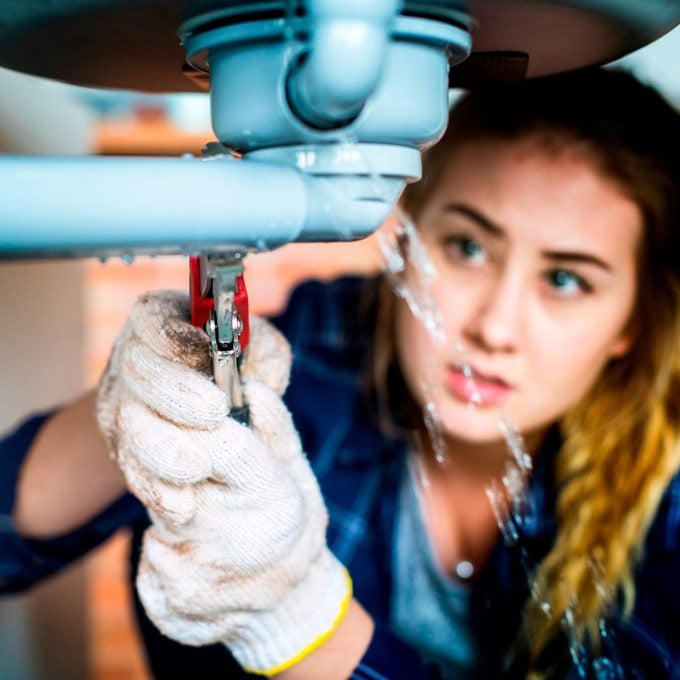10 Most Common Plumbing Code Violations DIYers Make
Updated: Jan. 15, 2024
Violating code can also cause serious difficulties down the line if you try to sell your house or make major renovations.

DIY repairs and installations can be a great way to save time and money. However, without the right planning, you could put your home in violation of plumbing code. This can make your plumbing less effective—or keep it from working at all.
Violating code can also cause serious difficulties down the line if you try to sell your house or make major renovations.
To identify some of the most common violations, we spoke with Minnesota-based inspector and journeyman plumber Eldon Rameaux. He helped us put together this list of the most common code violations.
On This Page
Improper or Illegal Materials
Using certain materials in your fixes will put you in violation of plumbing code. Corrugated piping, rubber fittings and other materials might work, but for various reasons, won’t be up to code.
Before installing any new piping, fittings or any other parts or components, research what kinds of plumbing materials will work best—and which will be a code violation.
Plus, check out these 100 plumbing goofs and other scary stuff.
Incorrectly Installed Kitchen or Bathroom Sink Traps
Incorrectly installing kitchen or bathroom sink traps—or using the wrong kind—can be a code violation.
Avoid using S-traps. These traps, which don’t include venting, are obsolete and almost always in violation of code.
Improperly Sized Drainage Piping
For any drain, the piping needs to be a specific size. Typically, if it’s in violation of plumbing code, it’s because it is too small for its function or the drain it’s attached to. It’s also possible to swing too far in the other direction, however, and use piping that’s too big.
Whenever you replace piping, make sure its size is within plumbing code limits.
Pressure Relief Valves on Water Heaters Improperly Installed or Plugged
A temperature and pressure relief valve, often called a “T and P valve” is a standard safety feature on a water heater. If the temperature or pressure inside a water heater gets too high, the water heater will explode.
A T and P valve prevents that by releasing water. But here’s the problem: When a T and P valve does its job, or simply leaks due to age, some people “fix” the drip by plugging the valve. That’s not just a code violation—it can lead to a deadly explosion.
Not Allowing Sufficient Space Around a Toilet
There needs to be sufficient clearance space around any toilet so it can be used comfortably. Specific clearance minimums will vary from area to area, so you’ll need to do some research before moving or installing a toilet.
This also applies to other bathroom furniture or appliances, like cabinets and sinks. Also, when moving cabinets, make sure you’re using the correct screws to put them back together.
Insufficient or Inaccessible Cleanouts
Cleanouts are access points that allow homeowners and plumbers to get into and unclog drains. Any plumbing system needs to be designed with a sufficient number of easily accessible cleanouts.
When making major changes to drains or plumbing, make sure they are in the proper locations.
Using a Sewer Cleanout as a Drain
The cleanout on your home or building’s main sewer line can’t be used as a drain. In general, you should keep the sewer cleanout sealed up and only open it if you need to clear a clog in the main sewer line.
Nonfunctional Water Shut Offs
If a water shut off doesn’t work because it’s damaged or broken, then it violates plumbing code. The last thing you want is water running when performing a DIY fix or installation.
Here are some fool-proof plumbing tips to prevent leaks.
Incorrect Venting
Plumbing needs to include properly vented traps to maintain a barrier between living spaces and the sewage system. Venting can be wrong in several ways, including flat venting, horizontal venting below a flood rim or no venting at all. Any of these can easily be a code violation.
Drainage Pipe Sloping
Any drainage pipe needs to slope a certain amount to keep water flowing and prevent clogs. The exact minimum slope varies from area to area, and may be as little as 1/16 in. per foot. Generally, 1/4 in. per foot is considered close to ideal.
Over-sloping a pipe should also be avoided. Keep pipe slopes below 1/2 in. per foot.
How to Find Your Plumbing Code
You can try to get plumbing code information on a local level from your city or municipality or you can view the uniform plumbing code (updated every three years). Up next, here’s what you need to know to find and repair hidden plumbing leaks.
